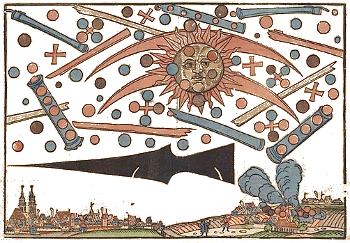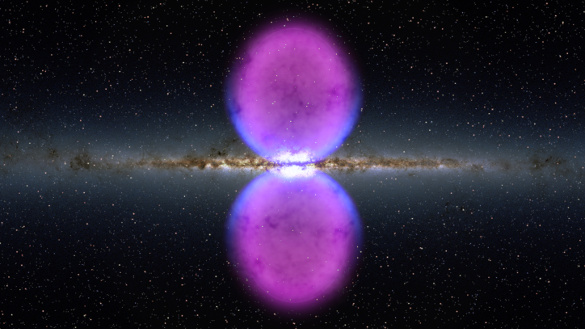Gamma Ray Bursts and the Fermi Paradox
March 19, 2015
I spent my
childhood in
Utica, New York. Although Utica is one of the most populous cities in
New York State, it's located in the center of a large, isolated,
rural area. As one of my
brothers said, If you're in Utica, you need to drive less than five minutes in any direction to see a
cow. Such environs are the preserve of
mystery.
Utica is near the site of
Griffiss Air Force Base (GAFB), an active
air installation until its
closure in 1995. The site remains as the
headquarters of the
Eastern Air Defense Sector of
NORAD, the North American Aerospace Defense Command (NORAD).
Utica was also a hotbed of
UFO activity in the
1950s. On July 1, 1954, an
F-94 jet interceptor was sent from GAFB to investigate an unknown flying object. A fire in the aircraft forced the
pilot and his
radar operator to eject from the
aircraft, and the
crashing aircraft killed four people and injured several others in a
suburb of Utica.[1] Some UFO web sites write that the plane had encountered a glowing, disc-shaped, object, and some sort of
heat ray forced the ejection.
Just a year later, on June 23, 1955, a 150-foot
ellipsoidal object passed close to a
civilian airliner near Utica. The object had several
windows emitting a bright,
blue-green light. The object was spotted by other aircraft, and it was tracked by radar all the way to
Boston. The
imputed speed of the object was several thousand
miles per hour.[2]
There are reports of UFOs still today, with many claiming a connection with
extraterrestrial intelligence; but, just like
Bigfoot, unequivocal proof has remained elusive. Nevertheless, UFOs and
space aliens have become part of our
culture, with visiting space aliens appearing in
movies and on
television. Recently,
Nickelodeon aired the 2009 movie, "
Aliens in the Attic."

Ancient UFOs.
Celestial phenomenon over Nüremberg, Germany, April 4, 1561, by Hanns Glaser.
(Woodcut, via Wikimedia Commons.)
The 1950s even saw some discussion among eminent
physicists about the possibility of space aliens visiting
Earth. During
lunchtime conversation at
Los Alamos National Laboratory,
Enrico Fermi discussed the possibility with
Edward Teller and
Herbert York. Fermi, in fact, made a
first principles estimate of the supposed number of extraterrestrial civilizations, predating the well known
Drake equation designed to do the same. Fermi later asked, "Where are they?"
Fermi had seen the problem of reconciling his estimate with the fact that we have not been visited by space aliens. This problem is known as the
Fermi paradox, and there are various
conjectures as to why the space aliens are absent. The
rare Earth hypothesis states that the
abiogenesis of life is harder than we suppose. It might be the case that intelligent life is rare and too widely spaced to allow contact.
There's the possibility that intelligent life always finds a way to destroy itself; or, a
technological singularity eventually happens, and the resultant artificial intelligence isn't interested in
exploration. Perhaps the intelligence is so advanced that Earth is not interesting enough for a visit; or, they
keep us isolated. There's also the possibility that life is frequently destroyed by natural events, one of which being
extinction-level meteor impact.
Although we may now be sufficiently adept
technologically to prevent our extinction by meteor impact, there's one danger in the
universe that could still cause our demise. That's a nearby
gamma ray burst. A rapidly rotating, high mass star collapsing into a neutron star or a black hole can release an intense burst of lethal radiation. Some distant gamma ray bursts have been intense enough to disturb Earth's
ionosphere.[3-4] I've written about one such burst in a previous article (Gamma-Ray Burst GRB 130427A, December 11, 2013).
On April 27, 2013, Earth was assaulted by an intense gamma ray burst, designated
GRB 130427A. Fortunately, the radiation from this burster was easily absorbed by Earth's atmosphere, since this burster was at a distance of about 3.8 billion
light years.[5] The peak gamma ray intensity of this burst was 95 billion
electron volts, and the isotropic energy release was one of the largest ever observed from a gamma ray burster.[5]
A gamma ray burst comparable to GRB 130427A has a
probability of less than 1 in 10 million of occurring in
our own galaxy,[6] but a gamma ray burst of lesser intensity close to the Earth would be devastating, destroying the ozone layer and
sterilizing most of
Earth's surface with
ultraviolet radiation.
Extinction-level gamma ray bursts near Earth are expected every 500 million years, and the Ordovician–Silurian extinction event, which caused the extinction of many marine species 450 million years ago, may have been caused by gamma rays from a nearby hypernova.[7]
Two researchers with affiliations at
The Hebrew University (Jerusalem, Israel), the
University of Barcelona (Barcelona, Spain), and
Harvard University (Cambridge, Massachusetts) have examined the role of gamma ray bursts in the extinction of life in our galaxy and other galaxies.[8-10] They examined the rate and
luminosity of gamma ray bursts, and they found a 60% probability that the Ordovician–Silurian extinction event was caused by such a burst, along with some other, interesting results.[8-9]
First, the high probability (95%) of lethal bursts within four
kiloparsecs (kpc) of our galactic center makes that region inhospitable to life.[8] Only at the periphery of the Milky Way, more than 10 kpc from the center, does the probability of life-extinguishing bursts drop below 50%.[8] The Milky Way galaxy has a
radius of about 50,000 light years, with the Earth about 27,000 light years from the galactic center. The Milky Way Galaxy will experience a 10
52 erg gamma ray burst about every billion years, and smaller bursts occur more often.[9] Second, and in my estimation their most interesting finding, is that life can exist in just 10% of galaxies.[8]
Calculations show that 91% of Earth's ozone layer would be destroyed by a gamma ray fluence of 100
kJ/
m2 over the course of a
month, which is enough to cause a life-extinction event.[10] Earth is fortunate to be in our particular galaxy, since gamma ray bursts are less frequent here than in low
mass galaxies composed mostly of
hydrogen and
helium with few heavy
elements. Our neighboring
Small Magellanic Cloud is one such low mass galaxy.[10] Gamma ray bursts would also have prevented life in nearly every galaxy formed in the first five billion years of the universe.[10]

These magenta false-colored gamma ray "bubbles," mapped by NASA's Fermi Gamma-ray Space Telescope, extend one galactic radius into space in each direction. They are a likely artifact of activity around the galaxy's central black hole in its early history. (NASA Goddard Space Flight Center image.)
References:
- Stu Beitler, "Walesville, NY Jet Fighter Crashes Into Homes, July 1954," GenDisasters, March 6, 2009.
- James E. McDonald, "UFOs and the Condon Report," Medical Students Colloquium of the Arizona College of Medicine, January 30, 1969 (via Princeton University Physics Department Web Site).
- Gamma-ray Burst Effects on the Ionosphere, Stanford University VLF Web Site.
- Dawn Levy, "Big gamma-ray flare from star disturbs Earth's ionosphere," Stanford Report, March 1, 2006.
- M. Ackermann and 181 Other Authors, "Fermi-LAT Observations of the Gamma-Ray Burst GRB 130427A," Science, vol. 343 no. 6166 (January 3, 2014), pp. 42-47, DOI: 10.1126/science.1242353.
- David Hopkins, "'Monster' cosmic explosion recorded," Telegraph (UK), November 22, 2013.
- Rebecca Morelle, "Gamma-ray burst brightest ever seen, BBC World Service, November 21, 2013.
- Tsvi Piran and Raul Jimenez, "Possible Role of Gamma Ray Bursts on Life Extinction in the Universe," Phys. Rev. Lett., vol. 113, Document No. 231102 (December 5, 2014), DOI: http://dx.doi.org/10.1103/PhysRevLett.113.231102. An arXiv preprint is available here.
- Michael Schirber, "Focus: Gamma-Ray Bursts Determine Potential Locations for Life," Physics, vol. 7, no. 124 (December 8, 2014), DOI: 10.1103/Physics.7.124.
- Marc Türler, "Gamma-ray bursts are a real threat to life," CERN Courier, Jan 27, 2015.
- NASA's Fermi Telescope Finds Giant Structure in our Galaxy, NASA Press Release, November 9, 2010.
- The Swift Gamma-Ray Burst Mission.
- Gamma Ray Burst Primer, NASA (PDF file).
Permanent Link to this article
Linked Keywords: Childhood; Utica, New York; New York State; rural area; sibling; brother; cattle; cow; paranormal; mystery; Griffiss Air Force Base; aircraft; 1993 Base Realignment and Closure Commission; closure; 1995; headquarters; Eastern Air Defense Sector; North American Aerospace Defense Command; NORAD; unidentified flying object; UFO; 1950s; Lockheed F-94 Starfire; F-94 jet interceptor; pilot; radar; aviation accident; crash; suburb; heat ray; ellipsoid; ellipsoidal; civilian airliner; window; blue-green; light; Boston; imputation; imputed; speed; miles per hour; extraterrestrial intelligence; Bigfoot; extraterrestrial life; space alien; culture; film; movie; television; Nickelodeon; Aliens in the Attic; astronomical object; celestial; phenomenon; Nüremberg, Germany; Wikimedia Commons; physicist; Earth; meal break; lunchtime; Los Alamos National Laboratory; Enrico Fermi; Edward Teller; Herbert York; Fermi problem; first principles estimate; Drake equation; Fermi paradox; conjecture; rare Earth hypothesis; abiogenesis of life; technological singularity; exploration; zoo hypothesis; isolation; extinction-level meteor impact; technology; technological; universe; gamma ray burst; rotation; rotating; mass; neutron star; black hole; electromagnetic radiation; ionosphere; GRB 130427A; Earth's atmosphere; light year; electronvolt; electron volt; isotropy; isotropic; energy; probability; Milky Way; our own galaxy; ozone layer; sterilization microbiology; sterilizing; lithosphere; Earth's surface; ultraviolet radiation; extinction event; extinction; Ordovician–Silurian extinction event; marine biology; marine; species; hypernova; researcher; The Hebrew University (Jerusalem, Israel); University of Barcelona (Barcelona, Spain); Harvard University (Cambridge, Massachusetts); luminosity; kiloparsec; radius; erg; joule; kJ; square meter; m2; month; mass; hydrogen; helium; element; Small Magellanic Cloud; magenta; false-color; NASA; Fermi Gamma-ray Space Telescope.